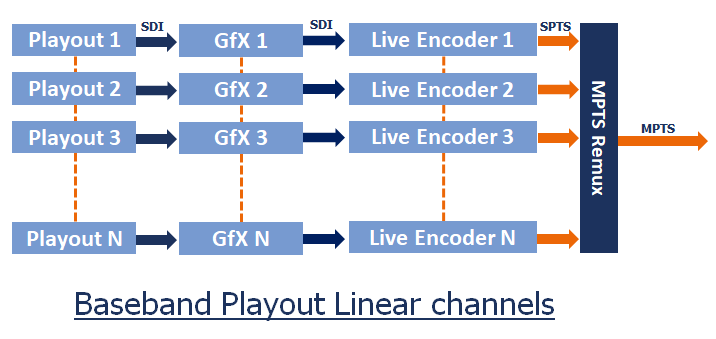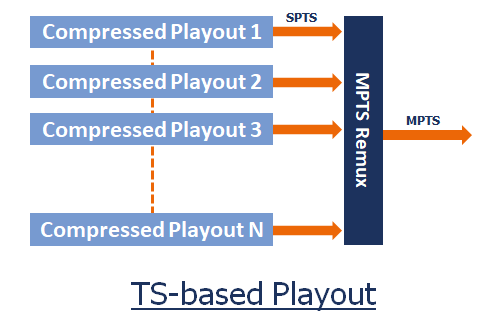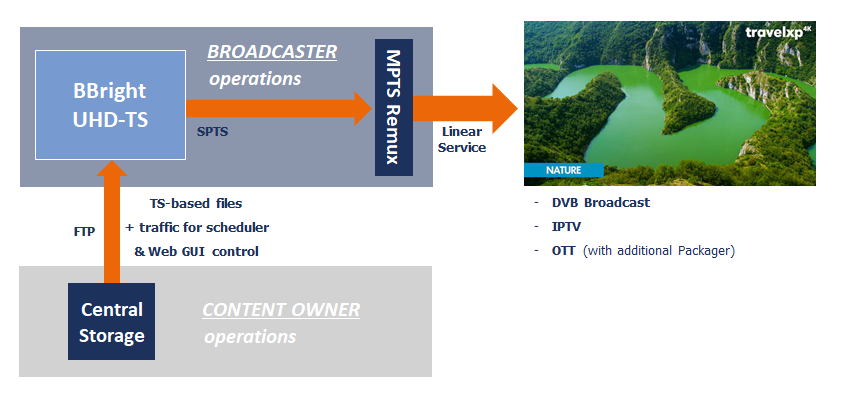BBright Advanced Stream Processing solution – Customer Use-cases
Blog & white papers
05 March 2020

File playout is an essential part of most TV stations’ technical operations.
Not all channels include live events, but instead, rely on linear playout. Cartoon or lifestyle channels, but also barker channels and some disaster recovery solutions are such examples. Linear playout-only is even more prevalent with the emerging 4K – Ultra HD channels for which live content is scarce and still more expensive to produce.
Benefits of a TS-based/compressed Playout
Processing live broadcast content Playout commonly takes two or three steps:
- A playout server outputs a baseband/SDI video signal.
- The channel’s graphical branding (i.e. adding logos) also occurs in the baseband domain.
- Live video encoding produces the final TSoIP stream either for immediate distribution to the viewer or for remuxing into a broadcast MPTS [Multiple Program Transport Stream].
Notes: sometimes, steps #1, #2 and #3 can be combined within some advanced C.i.a.B solution for SD and HD video resolutions. However, at this moment of time, most of 4K – Ultra HD TV channels still heavily rely on discrete boxes with minimal functional integration.

One fundamental issue is related to the video signal being heavily processed in the baseband/SDI domain, while the industry trend is currently to move to pure IP infrastructure; either with TSoIP or with ST-2110.
Considering working with baseband over ST-2110 is indeed a novel and seducing option, which is already deployed in some high-end Broadcaster’s MCR [Master Control Room] and Studios. It works very well up to Full-HD/1080p for which bandwidth remain limited to 3 Gbps. When it comes to 4K – Ultra HD channel, the necessary bit rate for uncompressed video over IP / ST-2110 imposes to use 25Gps NIC and IP switches. The cost of the IP infrastructure and the delicate timings (PTP clock, Wide and Narrow modes) becomes the two important issues expected during ST-2110 deployment in Ultra HD.
A back-up alternative, while still being IP-based, is to work with already pre-compressed AVC/H.264 or HEVC/H.265 TS-based playout pivot files. This solution brings several operational advantages, in particular for 4K – Ultra HD linear channels, while generating only some minimal drawbacks. Such approach also requires a lighter and more cost efficient playout server.

1- Pre-compressed HEVC playout pivot files
The HEVC Codec remains a complex video coding method, however absolutely mandatory for 4K – Ultra HD, or even for Full-HD/1080p with HDR distribution. Live HEVC encoders are still expensive nowadays and a file-based HEVC encoder will always deliver a better visual result for the same bit rate or provide room for bit rate reduction.
Moreover, lightly compressed pivot files for 4K – Ultra HD are typically delivered by post-production house/software in XAVC (500 – 600 Mbps) or in ProRes (above 1Gbps). A pre-compressed HEVC playout pivot file can be encoded @ 18 – 25 Mbps while still preserving a very good visual quality and be suitable for direct distribution to the end-users/consumers.
In term of video quality, the use of pre-compressed HEVC playout pivot files is the best way to maximize video quality: off-line file encoders can provide best of breed multi-pass and high quality encoding without the constraint of real-time.
2- Optimize the storage and transfer times
This massive bit rate reduction offered by the HEVC Codec has a direct positive impact on the storage space occupied within the playout server or on any content NAS or MAM [Media Asset Management].
File transfer delays throughout the infrastructure are also dramatically reduced by using pre-compressed HEVC playout files. This opens the doors to remote operations for which the playout server is physically located at a very different place than the TV channel operators and central content storage.
3- Ensure proper signalization and metadata
Metadata is more and more valuable to enrich content: SCTE-35 for Add insertion, Closed Captions and DVB subtitles, HDR static signalization or dynamic metadata, etc… Processing a channel through a chain of broadcast equipment can, possibly, alter or break some metadata.
Processing the playout directly using pre-compressed TS files allows to verify ahead of time (actually right after the off-line file encoding is done) that each required metadata are indeed present in the TS pivot file.
4- Simplify the workflow
To keep the video workflow simple is, usually, the best way to save time and money and lower the risks of failures. Pre-encoding off-line any video into an HEVC or AVC Transport Stream is nowadays a straightforward task which can run on dedicated appliances, or on multiple private Virtual Machine instances or even on encoders available in the public Cloud.
Off-line encoders also offer the possibility to burn channel logos/graphics and to add the proper HDR signalization, multiple Close Captions & DVB-Subtitles and different audio tracks/languages as well. In consequence, the same TS-processed playout pivot file can be used for distribution to different countries with individual and dedicated PID’s for each sub-titles and languages.
Preparing in advance the channel branding and applying it during the offline encoding stage is the only operational constraint related to TS-based playout.
5- The sunrise of 8K channels in 2020 …
Obviously, compressed TS playout pivot file is the only reasonable solution to select, at the present time, for 8K playout. Working in the uncompressed/baseband domain for 8K @ 60fps means to handle 48 Gbps (YES, Giga bits !!!) video bit rate which is close to an absolute state-of-the-art in term of video processing. This imposes as many as 16x 3G-SDI or 4x 12G-SDI cables between the playout and GfX unit then to the live encoder.
As opposed, a 60 – 65 Mbps HEVC Transport Stream is generally sufficient to preserve pristine 8K delivery quality. Although still a high bandwidth in its own, it becomes much more realistic than a baseband/uncompressed transmission within the technical rooms or a lightly compressed (XAVC or ProRes) approach for the pivot files.
BBright UHD-TS and Multi-TS compressed playout products are deployed at several Satellite or IPTV operators for different customer’s use-cases. So, let’s now introduce some of them.
Use Case #1: Remotely driven playout operation from the Content owner office
Tenths of 4K – Ultra HD channels are currently broadcast by market leading Satellite operators. A significant number of these channels are operated as TS-based/compressed linear playout without any live event insertion.
Content providers are able to remotely operate the playout solution, from anywhere in the World and just as it would be a Cloud solution, simply by accessing UHD-TS Web GUI and by transferring TS pivot files by FTP. The TS-compressed playout files can contains up to 5 audio PID’s/language and 10 subtitles PID’s (which can be remapped during playout) to cover a large geographical area thanks to Direct-To-Home satellite broadcast.
The only other operation is to regularly ingest a traffic file in order to fill-out the internal playout event scheduler. The embedded internal automation then cadences the various playout events. Offering an all-in-one Playout + Scheduler + Automation solution is both cost effective and avoids any third party vendor compatibility glitches or playout issues.

In order to ensure a high quality of service, compressed playout servers operate in a 1+1 configuration with automatic content replication from the ‘Main’ unit onto the ‘Back-up’ unit. This functionality minimizes content transfer sessions and time.
The advanced stream processing capability, such as PCR & Continuity Counter reprocessing + PTS/DTS re-stamping has proven to be essential in order to ensure TS to TS files seamless audio/video transitions at the decoder level.
Use Case #2: Multiple SPTS source for Labs or Barker channels and Disaster recovery
When a mix of SD, HD, Full-HD/1080p, UHD/2160p channels is required and playout density becomes a major decision factor, then using BBright Multi-TS compressed playout solution is an ideal way to go as it can deliver multiple SPTS [Single Program Transport Stream].
The Multi-TS playout configuration is license-scalable, starting from 2x channels and up to 20x channels, with a typical cumulative bandwidth of 500 Mbps.
Deployed uses-cases, either in Labs or for 24 – 7 operations, could be briefly described as:
- Multi-TS is selected by Telecom Operators to feed their internal lab network(s) and test the behavior/compliancy of various STB models. Advanced stream processing functionalities such as GoP cleaning is very valuable in such test environment as it allows to work with any pre-captured TS files.
- Multi-TS is often used to generate ‘N’ barker channels from a single IT server, usually in a simple looping playlist mode (i.e. without the need of a traffic file)
- Multi-TS also finds a home in linear playout for Disaster Recovery applications being a dense, license-scalable and cost-effective 1+1 secured playout solution.
